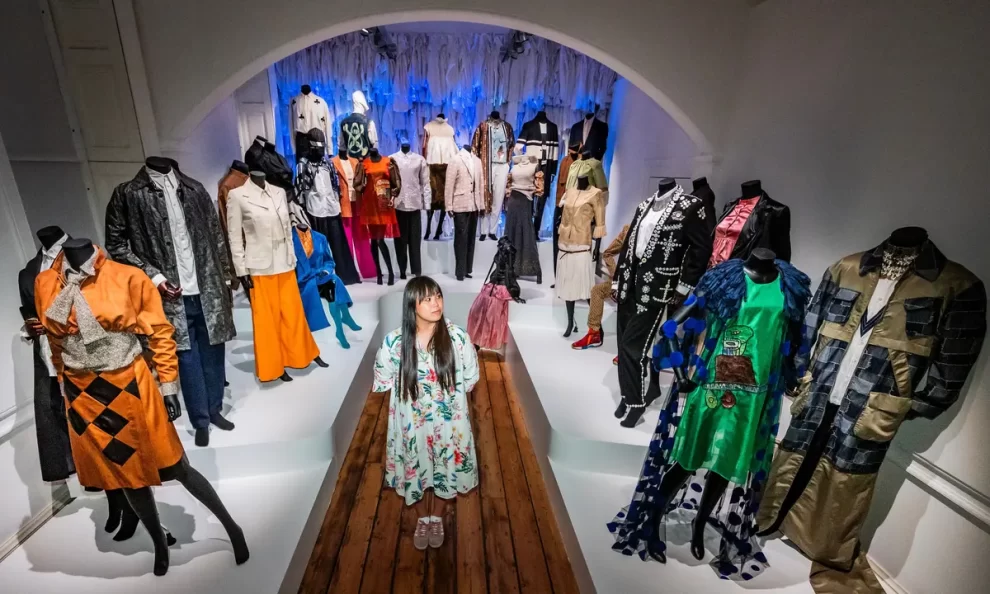Somerset House exhibition showcases design legends and new wave of talent
Black designers have long been crucial to the history of UK fashion, with names such as Bruce Oldfield, Ozwald Boateng and Walé Adeyemi redefining British style over the past half century. While recent years have seen a new class of black British designers, including Grace Wales Bonner, Martine Rose and Bianca Saunders, become household names in fashion, there are still generations of artistic talents whose contributions have been left unacknowledged.
An exhibition at Somerset House titled The Missing Thread: Untold Stories of Black British Fashion, which opens this week, seeks to redress that by exploring the legacy of black diasporic designers and artisans from the 1970s through to the present day.
The exhibition showcases the work of design legends such as Boateng and Oldfield but also features new commissions from Saunders, Saul Nash and Nicholas Daley, designers at the forefront of a new wave of British fashion talent, as well as lesser-known artists such as London-based couturier Ninivah Khomo and patternmaker Monisola Omotoso.
At the heart of the show is the work of influential designer and tailor Joe Casely-Hayford, who died in 2019. The final section of the exhibition is dedicated to his 40-year career and displays the work he made with his wife, Maria, and son, Charlie, in an exhibition format for the first time.
The Missing Thread was curated by Harris Elliott, Andrew Ibi and Jason Jules, of the Black Orientated Legacy Development (Bold) agency. Elliott describes the show as “a labour of love and design intent to create a narrative that would be really immersive and engaging”.

First conceived by Elliott and Ibi seven years ago as “a presentation to support the emerging African diaspora designers that were coming through”, Elliott says the show’s genesis began in earnest in 2020, after the killing of George Floyd.
“There had been a lot of conversations in the media and academia about decolonising, and changing the way people think. Andrew was involved in a conversation with the [British] Fashion Council and, when it finished, he rang me and said: ‘That idea we’ve been talking about for years, I think now would be the time to bring it to life.’”
Elliott says he hopes The Missing Thread will provide a “roadmap” for industries seeking to decolonise and centre black voices.
While focusing on fashion, the exhibition also zeroes in on key moments in black culture –such as Nelson Mandela’s release from prison and the 1981 New Cross fire – and seeks to paint a broader picture of how black British culture has developed and changed since the 1970s.
Many of those historic moments have fashion woven into them. Among the remarkable artefacts in the exhibition, for example, is the England football kit designed by Savile Row tailor Charlie Allen in 2009.
“Many people don’t know that was a black British designer,” says Elliott. “That’s a hugely important story for one of our biggest cultural exports – the fact that was by a black designer is something we should be celebrating, not just as black people, but as Brits.”
If traditional exhibitions tend to showcase past work, it was crucial, Elliott says, that The Missing Thread looked to the future. To that end, Bold commissioned designers such as Saunders and Daley to respond to the show’s themes.
Daley’s installation, Knitted Roots, is a knitted lounge set that riffs on the interior design hallmarks of Caribbean homes, as well as his Scottish heritage. “I wanted to highlight the use of craft and a DIY sensibility, which has always been a part of my creations. Historically, on both sides of my family, knitting has been a form of expression,” he says.
Visitors to the exhibition can sit in Daley’s installation and listen to a playlist, curated by him and inspired by Casely-Hayford’s collaborations with musicians. “I think it shows the influence of what the black British community has brought forward, not just within fashion, but also different kinds of creative mediums.”
Saunders’ contribution to the show is a three-piece outfit inspired by Althea McNish, a celebrated textile designer known for her brightly coloured, intricate screenprints. Saunders says exhibitions like The Missing Thread “help people dream bigger”. “It makes people feel like they can be part of a world that’s more diverse and has a bit more of a colourful palette [than] the timeline that actually exists,” she says.
The Missing Thread opens on 21 September, at the end of London fashion week. Daley says that, while he’s seen the industry take great strides in terms of diversity and representation over the decade since he graduated, “there’s still work to be done for my generation to keep pushing it, whether in the form of a runway show or exhibition”.
“There are a lot of black British designers and creatives and photographers and artists who have not been recognised, given the space or accolades, for many years,” he says.
Source : The Guardian






















